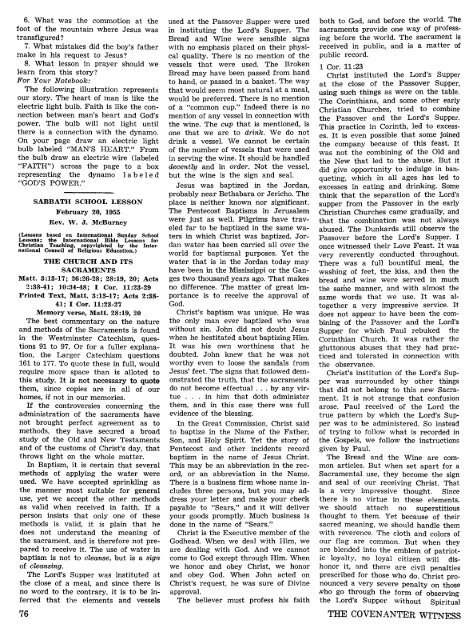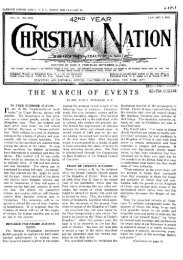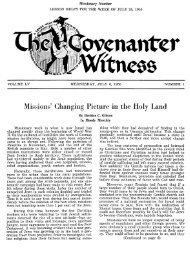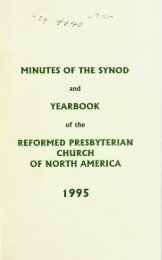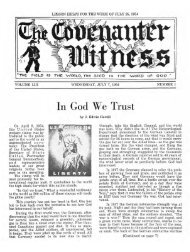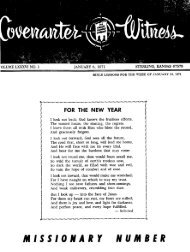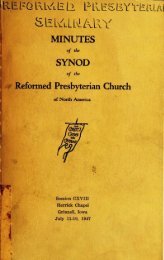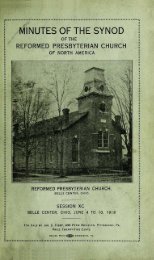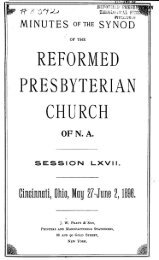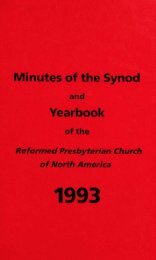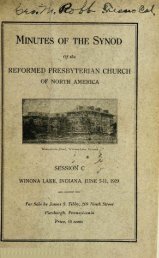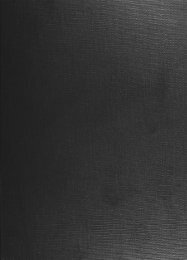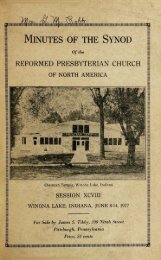Covenanter Witness Vol. 54 - Rparchives.org
Covenanter Witness Vol. 54 - Rparchives.org
Covenanter Witness Vol. 54 - Rparchives.org
You also want an ePaper? Increase the reach of your titles
YUMPU automatically turns print PDFs into web optimized ePapers that Google loves.
in<br />
cup."<br />
6. What was the commotion at the<br />
foot of the mountain where Jesus was<br />
transfigured<br />
7. What mistakes did the boy's father<br />
make in his request to Jesus<br />
8. What lesson in prayer should we<br />
learn from this story<br />
For Your Notebook:<br />
The following illustration represents<br />
our story. The heart of man is like the<br />
electric light bulb. Faith is like the con<br />
nection between man's heart and God's<br />
power. The bulb will not light until<br />
there is a connection with the dynamo.<br />
On your page draw an electric light<br />
bulb labeled "MAN'S HEART." From<br />
the bulb draw an electric wire (labeled<br />
"FAITH")<br />
across the page to a box<br />
representing the dynamo labeled<br />
"GOD'S POWER."<br />
SABBATH SCHOOL LESSON<br />
February 20, 1955<br />
Rev. W. J. McBurney<br />
(Lessons based on International Sunday School<br />
Lessons; the International Bible Lessons for<br />
Christian Teaching, copyrighted by the Inter.<br />
national Council of Religious Education.)<br />
THE CHURCH AND ITS<br />
SACRAMENTS<br />
Matt. 3:13-17; 26:26-28; 28:19, 20; Acts<br />
2:38-41; 10:34-48; I Cor. 11:23-29<br />
Printed Text, Matt. 3:13-17; Acts 2:38-<br />
41; I Cor. 11:23-27<br />
Memory verse, Matt. 28:19, 20<br />
The best commentary on the nature<br />
and methods of the Sacraments is found<br />
in the Westminster Catechism, ques<br />
tions 91 to 97. Or for a fuller explana<br />
tion, the Larger Catechism questions<br />
161 to 177. To quote these in full, would<br />
require more space than is alloted to<br />
this study. It is not necessary to quote<br />
them, since copies are in all of our<br />
homes, if not in our memories.<br />
If the controversies concerning the<br />
administration of the sacraments have<br />
not brought perfect agreement as to<br />
methods,<br />
study<br />
they have secured a broad<br />
of the Old and New Testaments<br />
and of the customs of Christ's day, that<br />
throws light on the whole matter.<br />
In Baptism, it is certain that several<br />
methods of applying the water were<br />
used. We have accepted sprinkling as<br />
the manner most suitable for general<br />
use, yet we accept the other methods<br />
as valid when received in faith. If a<br />
person insists that only one of these<br />
methods is valid, it is plain that he<br />
does not understand the meaning of<br />
the sacrament, and is therefore not pre<br />
pared to receive it. The use of water in<br />
baptism is not to cleanse, but is a sign<br />
of cleansing.<br />
The Lord's Supper was instituted at<br />
the close of a meal, and since there is<br />
no word to the contrary, it is to be in<br />
ferred that the elements and vessels<br />
76<br />
used at the Passover Supper were used<br />
in instituting the Lord's Supper. The<br />
Bread and Wine were sensible signs<br />
with no emphasis placed on their physi<br />
cal quality. There is no mention of the<br />
vessels that were used. The Broken<br />
Bread may have been passed from hand<br />
to hand, or passed in a basket. The way<br />
that would seem most natural at a meal,<br />
would be preferred. There is no mention<br />
of a "common<br />
Indeed there is no<br />
mention of any vessel in connection with<br />
the wine. The cup that is mentioned, is<br />
one that we are to drink. We do not<br />
drink a vessel. We cannot be certain<br />
of the number of vessels that were used<br />
in serving the wine. It should be handled<br />
decently and in order. Not the vessel,<br />
but the wine is the sign and seal.<br />
Jesus was baptized in the Jordan,<br />
probably near Bethabara or Jericho. The<br />
place is neither known nor significant.<br />
The Pentecost Baptisms in Jerusalem<br />
were just as well. Pilgrims have trav<br />
eled far to be baptized in the same wa<br />
ters in which Christ was baptized. Jor<br />
dan water has been carried all over the<br />
world for baptismal purposes. Yet the<br />
water that is in the Jordan today may<br />
have been in the Mississippi or the Gan<br />
ges two thousand years ago. That makes<br />
no difference. The matter of great im<br />
portance is to receive the approval of<br />
God.<br />
Christ's baptism was unique. He was<br />
the only<br />
man ever baptized who was<br />
without sin. John did not doubt Jesus<br />
when he hestitated about baptizing Him.<br />
It was his own worthiness that he<br />
doubted. John knew that he was not<br />
worthy even to loose the sandals from<br />
Jesus'<br />
feet. The signs that followed dem<br />
onstrated the truth, that the sacraments<br />
do not become effectual ...<br />
by any vir<br />
tue ... him that doth administer<br />
them, and in this case there was full<br />
evidence of the blessing.<br />
In the Great Commission, Christ said<br />
to baptize in the Name of the Father,<br />
Son, and Holy Spirit. Yet the story of<br />
Pentecost and other incidents record<br />
baptism in the name of Jesus Christ.<br />
This may be an abbreviation in the rec<br />
ord, or an abbreviation in the Name.<br />
There is a business firm whose name in<br />
cludes three persons, but you may ad<br />
dress your letter and make your check<br />
payable to "Sears," and it will deliver<br />
your goods promptly. Much business is<br />
done in the name of "Sears."<br />
Christ is the Executive member of the<br />
Godhead. When we deal with Him, we<br />
are dealing<br />
with God. And we cannot<br />
come to God except through Him. When<br />
we honor and obey Christ, we honor<br />
and obey God.<br />
When John acted on<br />
Christ's request, he was sure of Divine<br />
approval.<br />
The believer must profess his faith<br />
both to God, and before the<br />
world. The<br />
sacraments provide one way of profess<br />
ing before the world. The sacrament is<br />
received in public, and is a matter of<br />
public record.<br />
1 Cor. 11:23<br />
Christ instituted the Lord's Supper<br />
at the close of the Passover Supper,<br />
using such things as were on the table.<br />
The Corinthians, and some other early<br />
Christian Churches, tried to combine<br />
the Passover and the Lord's Supper.<br />
This practice in Corinth, led to excess<br />
es. It is even possible that some joined<br />
the company because of this feast. It<br />
was not the combining of the Old and<br />
the New that led to the abuse. But it<br />
did give opportunity to indulge in ban<br />
queting, which in all ages has led to<br />
excesses in eating and drinking. Some<br />
think that the separation of the Lord's<br />
supper from the Passover in the early<br />
Christian Churches came gradually, and<br />
that the combination was not always<br />
abused. The Dunkards still observe the<br />
Passover before the Lord's Supper. I<br />
once witnessed their Love Feast. It was<br />
very reverently conducted throughout.<br />
There was a full bountiful meal, the<br />
washing of feet, the kiss, and then the<br />
bread and wine were served in much<br />
the same manner,<br />
and with almost the<br />
same words that we use. It was al<br />
together a very<br />
impressive service. It<br />
does not appear to have been the com<br />
bining of the Passover and the Lord's<br />
Supper for which Paul rebuked the<br />
Corinthian Church. It was rather the<br />
gluttonous abuses that they had prac<br />
ticed and tolerated in connection with<br />
the observance.<br />
Christ's institution of the Lord's Sup<br />
per was surrounded by other things<br />
that did not belong to this new Sacra<br />
ment. It is not strange that confusion<br />
arose. Paul received of the Lord the<br />
true pattern by which the Lord's Sup<br />
per was to be administered. So instead<br />
of trying to follow what is recorded in<br />
the Gospels, we follow the instructions<br />
given by Paul.<br />
The Bread and the Wine are com<br />
mon articles. But when set apart for a<br />
Sacramental use, they become the sign<br />
and seal of our receiving Christ. That<br />
is a very impressive thought.<br />
Since<br />
there is no virtue in these elements,<br />
we should attach no superstitious<br />
thought to them. Yet because of their<br />
sacred meaning, we should handle them<br />
with reverence. The cloth and colors of<br />
our flag<br />
are common. But when they<br />
are blended into the emblem of patriot<br />
ic loyalty, no loyal citizen will<br />
dis<br />
honor it, and there are civil penalties<br />
prescribed for those who do. Christ pro<br />
nounced a very severe penalty on those<br />
,vho go through the form of observing<br />
the Lord's Supper without Spiritual<br />
THE COVENANTER WITNESS


